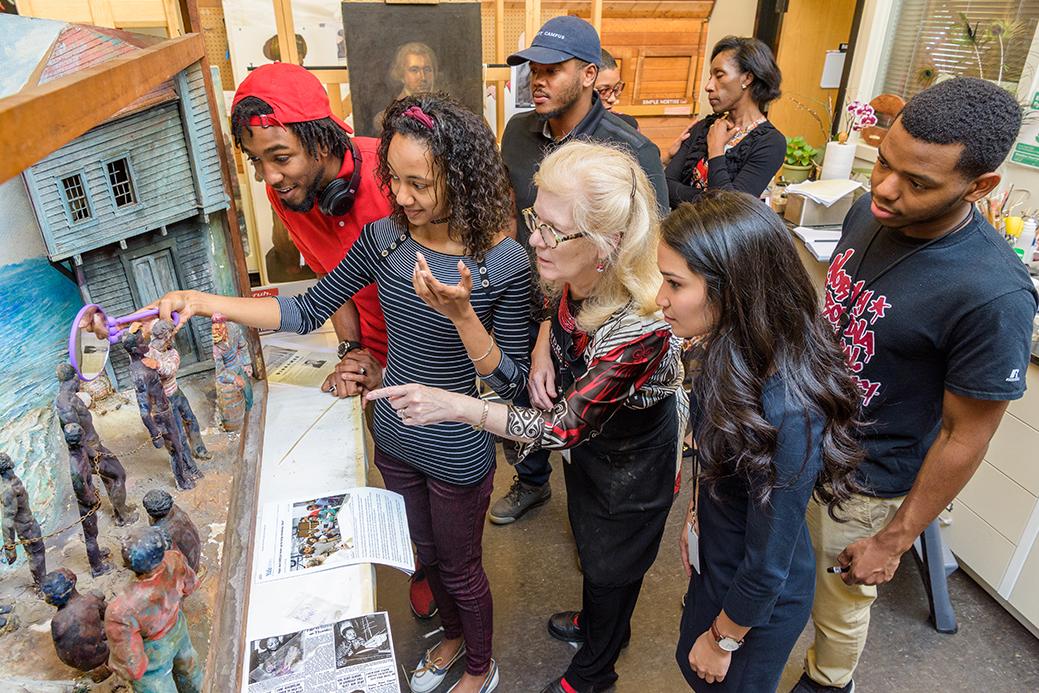Matthew Fields was a recent pre-program intern at the Lunder Conservation Center, as part of the Smithsonian Conservation Internship for Broadening Access (CIBA). He is currently a senior at the University of Arkansas at Pine Bluff, pursuing a BA in art.
In the summer of 2017, I had the privilege of working on the dioramas from the 1940 Chicago "American Negro Exhibition." Being a part of the inaugural Two-Week Introduction into Practical Conservation (TIPC) program was an invaluable experience. I spent those weeks on the grounds of the Winterthur Museum and the University of Delaware, and was immersed in the field of museum studies for the first time.
My colleagues and I were tasked with beginning the treatment of a diorama depicting the arrival of slaves on Dutch ships in the 1400s. After a bit of research, we were able to learn that this diorama was one of 33 that were created for the 1940 exhibition. At this point, there were still many questions to be answered: how many dioramas still exist? What was their purpose? Who created the dioramas and why?
Because of our curiosity, we dug deeper into our research and found that while there were originally 33 dioramas created, only 20 remain—the ones in which Charles C. Dawson chose the iconography. (Dawson was a member of the faculty of the Tuskegee Institute of Alabama as artist-in-residence as well as curator of the Museum of Negro Art and Culture and of the George Washington Carver Museum). He selected his subjects based on the rich and varied contributions of African Americans to history.
Finding out these different pieces of information helped us to recognize the importance of our project. Beyond our extensive individual and collaborative research, we got a crash course in conservation and started treating the diorama by examining, consolidating, and minor surface cleaning. These two weeks were life changing for me. I learned about the ever-expanding world of conservation, the professional potential that this field holds for someone like me, and most importantly, the existence of these dioramas.
Fast forward to 2018. This past summer, there were three more dioramas from the series being conserved. As a Smithsonian Conservation Intern for Broadening Access (CIBA), I had the luxury of being able to spend my internship with another one of the dioramas, Reconstruction after the War, carrying out its treatment with a fellow CIBA intern, Tamara Dissi. This opportunity was a step forward for me educationally as Tamara and I helped mentor three incoming TIPC interns.
During my internship, I spent ten weeks in the heart of Washington, D.C., working at the Lunder Conservation Center at the Smithsonian American Art Museum (SAAM)-- the largest collection of American art in the country. The diorama is inspired by Eastman Johnson's 1859 painting Negro Life at the South. Since this painting is in the collection of the New York Historical Society, I was unable to refer to the painting in person. However, the digital reference in combination with the other paintings in SAAM's collection by the likes of Johnson or Winslow Homer, provide wonderful context on the subject matter, compositional components, and cultural perspective. Compiling the knowledge that we find on each one of the dioramas is a truly wonderful experience, especially knowing that research holds a deep impact.
There lies the difference between my two summer experiences treating the dioramas. In 2017, I played a small role in the grand scheme of things, with my minimal experience doing hands-on treatment. That opportunity led me to grow into the role I carried out this summer at Lunder, in which I was able to start and finish the treatment process and work with new TIPC students. This motivated me and inspired me to help pave the way for a younger generation of diverse students. I would like to help students in non-privileged environments become aware of the possibilities that the field of conservation can provide and the importance of the work that is being done in these museums every day.
The diorama will continue to be treated through October at Lunder. You're welcome to come have a look.
For more information about the Lunder Conservation Center, check out our upcoming programs and tours and follow us on Facebook and Twitter.























